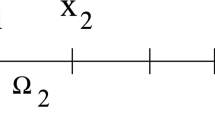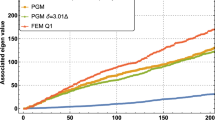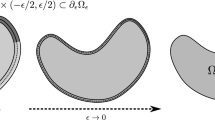Summary
The paper discusses error estimation and adaptive finite element procedures for elasto-static and dynamic problems based on superconvergent patch recovery (SPR) techniques. The SPR is a postprocessing procedure to obtain improved finite element solutions by the least squares fitting of superconvergent stresses at certain sampling points in local patches. An enhancement of the original SPR by accounting for the equilibirum equations and boundary conditions is proposed. This enhancement improves the quality of postprocessed solutions considerably and thus provides an even more effective error estimate. The patch configuration of SPR can be either the union of elements surrounding a vertex node, thenode patch, or, the union of elements surrounding an element, theelement patch. It is shown that these two choices give normally comparable quality of postprocessed solutions. The paper is also concerned with the application of SPR techniques to a wide range of problems. The plate bending problem posted in mixed form where force and displacement variables are simultaneously used as unknowns is considered. For eigenvalue problems, a procedure of improving eigenpairs and error estimation of the eigenfrequency is presented. A postprocessed type of error estimate and an adaptive procedure for the semidiscrete finite element method are discussed. It is shown that the procedure is able to update the spatial mesh and the time step size so that both spatial and time discretization errors are controlled within specified tolerances. A discontinuous Galerkin method for solving structural dynamics is also presented.
Similar content being viewed by others
References
Abdulwahab, F. (1995),Postprocessing Techniques and Adaptivity in the Finite Element Method. Ph.D. Thesis, Publ. 95:8, Dept. of Structural Mechanics, Chalmers University of Technology, Sweden.
Abdulwahab, F. and Wiberg, N.-E. (1996), “Quality assured plate solution”, ECCOMAS'96, John Wiley & Sons.
Andreev, A.B. and Lazarov, R.D. (1986), “Superconvergence of the gradient for quadratic triangular finite elements”,Numer. Methods P.D.E.'s,4, 15–32.
Avrashi, J. and Cook, R.D. (1993), “New error estimation for C0 eigenproblems in finite element analysis”,Eng. Comput.,10, 243–256.
Babuska, I. (1993), “Courant element: before and after”,Finite Element Methods, fifty years of the Courant element, M. Krizek, P. Neittaanmaki and R. Stenberg (eds.), 37–52.
Babuska, I. and Gui, W. (1986), “Basic principles of feedback and adaptive approaches in the finite element method”,Comput. Methods Appl. Mech. Eng.,55, 27–42.
Babuska, I., Strouboulis, T., Updhay, C.S., Gangaraj, S.K. and Copps, K. (1994), “Validation of a posteriori error estimators by numerical approach”,Int. J. Num. Methods Eng.,37, 1073–1123.
Bakker, M. (1981), “A note on C0 Galerkin methods for two point boundary problems”,Numer. Math.,38, 447–453.
Barlow, J. (1976). “Optimal stress location in finite element method”,Int. J. Num. Methods Eng.,10, 243–251.
Belytschko, T. and Tabbara, M. (1993), “H-adaptive finite element methods for dynamic problems, with emphasis on localization”,Int. J. Numer. Methods Eng.,36, 4245–4265.
Bernspång, L., Küssner, M., Samuelsson, A., Wriggers, P. (1995), “The Consistent Strain Method in Finite Element Plasticity”,Comp. & Struct.,54, No. 1, 27–33.
Blacker, T. and Belytschko, T. (1994), “Superconvergent patch recovery with equilibrium and conjoint interpolant enhancements”,Int. J. Numer. Methods Eng.,37, 517–536.
Cantin, G., Loubignac, G. and Touzot, G. (1978), “An iterative algorithm to build continuous stress and displacement solutions”,Int J. Numer. Methods Eng.,12, 1493–1506.
Chen, C. M. (1981), “Superconvergence of the finite element solutions and their derivatives”,Numer. Math. J. Chinese Univ.,3, 118–125.
Cook, R.D. (1982), “Loubignac's iterative method in finite element elastostatics”,Int J. Numer. Methods Eng.,18, 319–335.
Demkowicz, L., Oden, J.T. and Babuska, I (eds.), (1992),Proceedings of the Second Workshop on Reliability in Computational Mechanics, Technical Univ. of Cracow, Cracow, Poland, Oct. 1991,Comput. Methods Appl. Mech. Engrg.,101.
Douglas, J. and Dupont, T. (1974), “Galerkin approximations for the two point boundary problems using continuous piecewise polynomials”,Numer. Math.,22, 99–109.
Friberg, O., Möller, P., Makovicka, D. and Wiberg, N.E. (1987), “An adaptive procedure for eigenvalue problems using hierarchical finite element method”,Int. J. Num. Meth. Engng.,24, 319–335.
Hughes, T.J.R. and Hulbert, G. (1988), “Space-time finite element methods for elastodynamics: Formulations and error estimates”,Comput. Methods Appl. Mech. Engrg.,66, 339–363.
Hulbert, G. (1989), “Space-time finite element methods for second order hyperbolic equations”, Ph.D. Thesis, Department of Mechanical Engineering, Stanford University, Stanford.
Hulbert, G. and Hughes, T.J.R. (1990), “Space-time finite element methods for second order hyperbolic equations”,Comput. Methods Appl. Mech. Engng.,84, 327–348.
Hulbert, G. (1992), “Time finite element methods for structural dynamics”,Int. J. Numer. Meth. Engng.,33, 307–331.
Johnson, C. (1993), “Discontinuous Galerkin finite element methods for second order hyperbolic problems”,Comput. Meth. Appl. Mech. Engng.,107, 117–129.
Joo, K.J. and Wilson, E.L. (1988), “An adaptive finite element technique for structural dynamic analysis”,Comput. & Struct.,30, 1319–1339.
Krizck, M. and Neittaanmki, P. (1987), “On superconvergence techniques”,Acta Appl. Math.,9, 175–198.
Kvamsdal, T. and Okstad, K.M. (1995), “Superconvergent patch recovery based on polynomials satisfying interior equilibrium”, R. Larsson and N.-E. Wiberg (eds.),NSCM VIII, Eighth Nordic Seminar on Computational Mechanics.
Larsson, R., Runesson, K. and Ottosen, N.S. (1993), “Discontinuous displacement approximation for capturing plastic localization”,Int. J. Numer. Meth. Engng.,36, 2087–2105.
Lesaint, P. and Zlamal (1979), “Superconvergence of the gradient of finite element solutions’,RAIRO Anal. Numer.,13, 139–166.
Levine, N. (1985), “Stress sampling points for linear triangles in the finite element methods”,Numer. Anal.,5, 407–427.
Li, X.D. (1996), “Adaptive Finite Element Procedures in Structural Dynamics”, Ph.D. thesis, Publ 96:2, Dept. of Structural Mechanics, Chalmers Univ. of Technology, Sweden.
Li, X.D. and Wiberg, N.-E. (1994), “A posteriori error estimate by element patch postprocessing, adaptive analysis in energy and L2 norms”,Comput. & Struct.,53, 907–919.
Li, X.D. and Wiberg, N.-E. (1996), “Structural dynamic analysis by a time-discontinuous Galerkin finite element method”,Int. J. Numer. Meth. Engng.,39, 2131–2152.
Li, X.D. and Wiberg, N.-E. (1995), “Implementation and adaptivity of a space-time finite element method in structural dynamics”, Publ. 95:17, Dept. of Structural Mechanics, Chalmers Univ. of Technology, (submitted toComput. Methods Appl. Mech. Engng.).
Li, X.D., Zeng, L.F. and Wiberg, N.-E. (1993), “A simple local error estimator and an adaptive time-stepping procedure for direct integration method in dynamic analysis”,Commun. Numer. Meth. Engng.,9, 273–292.
Mackerle, J., (1994), “Error analysis, adaptive techniques and finite and boundary elements—A bibliography (1992–1993)”,Finite Elements in Analysis and Design,17, 231–246.
Mackinnon, R.J. and Carey, G.F. (1989), “Superconvergent derivatives: A Taylor series analysis”,Int. J. Numer. Meth. Engng.,28, 489–509.
Möller, P.M. (1993), “High-order hierarchical A- and L-stable integration methods”,Int. J. Numer. Meth. Engng.,36, 2607–2624.
Newmark, N.M. (1959), “A method of computation for structural dynamics”,J. Eng. Mech. Div., ASCE,8, 67–94.
Owen, D.R.J., Oñate, E. and Hinton E. (eds.). (1992), “Computational Plasticity: Fundamentals and Applications”,Proceedings of the Third International Conference, held in Barcelona, Spain, Pincridge Press, Swansca, U.K.
Selman, A. and Hinton, E. (1993), “Two dimensional transient dynamic analysis with adaptive mesh refinement”,Commun. Numer. Meth. Engng.,9, 825–836.
Wahlbin, L.B. (1991), “Local behaviour in finite element methods”, In: P.G. Ciarlet and J.L. Lions (eds.), “Handbook of Numerical Analysis”, Vol. II, Finite Element Method (Part 1), Elsevier, 355–522.
Wahlbin, L.B. (1995), “Superconvergence in Galerkin finite element methods”,Lecture notes in Mathematics 1605, Springer-Verlag, Berlin/Heidelberg.
Wiberg, N.-E. and Abdulwahab, F. (1992), “An efficient postprocessing technique for stress problems based on superconvergent derivatives and equilibrium”, In Ch. Hirshet al. (eds.), “Numerical Methods in Engineering '92, Elsevier, Amsterdam, 25–32.
Wiberg, N.-E. and Abdulwahab, F. (1993), “Patch Recovery based on superconvergent derivatives and equilibrium”,Int. J. Numer. Meth. Engng.,36, 2703–2724.
Wiberg, N.-E. and Abdulwahab, F. (1994), “Error estimation with postprocessed FE-solutions”,Proceeding 2nd Conf. on Comp. Struc. Technology, Athens, Greece.
Wiberg, N.-E., Abdulwahab, F. and Ziukas, S. (1994), “Enhanced superconvergent patch recovery incorporating equilibrium and boundary conditions”,Int. J. Numer. Meth. Engng.,37, 3417–3440.
Wiberg, N.-E., Abdulwahab, F. and Ziukas, S. (1995), “Improved element stresses for node and element patches using superconvergent patch recovery”,Commun. Numer. Meth. Engng.,11, 619–627.
Wiberg, N.-E. and Bausys, R. (1995), “Error estimation for eigenfrequencies and eigenmodes in dynamics”, Pahl & Werner (eds.),Computing in Civil and Building Engineering. Balkena, Rotterdam, 611–616.
Wiberg, N.-E., Bausys, R. and Hager P. (1996), “Improved eigenfrequencies and eigenmodes in free vibration analysis”,3rd Int. Conf. Comp. Struct. Technology, Budapest, Hungary, August 21–23.
Wiberg, N.-E. and Li, X.D. (1993), “A postprocessing technique and an a posteriori error estimate for the Newmark method in dynamic analysis”.Earthquake Engng. Struct. Dyn.,22, 465–489.
Wiberg, N.-E. and Li, X.D. (1993), “Earthquake response analysis of a concrete dam by an adaptive time-stepping algorithm”,International Symposium on Application of Computer Methods in Rock Mechanics and Engineering, Xian, China, May 24–28.
Wiberg, N.-E. and Li, X.D. (1994), “Superconvergent patch recovery of finite element solution and a posteriori L2 norm error estimate”,Commun. Numer. meth. Engng.,10, 313–320.
Wiberg, N.-E. and Li, X.D. (1994), “A postprocessed error estimate and an adaptive procedure for the semidiscrete finite element method in dynamic analysis”,Int. J. Numer. Meth. Engng.,37, 3583–3603.
Wiberg, N.-E. and Li, X.D. (1995), “A HPC-solver for dynamics with quality assurance”, Publ. 95:16, Dept. of Structural Mechanics, Chalmers Univ. of Technology.
Wiberg, N.-E., Li, X.D. and Abdulwahab, F. (1996), “Adaptive finite element procedures in clasticity and plasticity”,Engineering with Computers,12, 120–141.
Wiberg, N.E. and Möller, P. (1988), “Formulation and solution of hierarchical finite element equations”,Int. J. Numer. Meth. Engng.,26, 1213–1233.
Wiberg, N.E., Zeng, L.F. and Li, X.D. (1992), “Error estimation and adaptivity in elastodynamics”,Comput. Meth. Appl. Mech. Engng.,101, 369–395.
Wilson, R.R. (1985), “Two dimensional and plate bending applications”, C.A. Brebbia, H. Tottenham, G.B. Warburton, J.M. Wilson and R.R. Wilson (eds.),Vibrations of engineering structures, Lecture notes in engineering, Springer-Verlag 130–147.
Zeng, L.F. and Wiberg, N.-E. (1992), “Spatial mesh adaptation in semidiscrete finite element analysis of linear elastodynamic problems”,Comput. Mech.,9, 5, 315–332.
Zienkiewicz, O.C. and Zhu, J.Z. (1987), “A simple error estimator and adaptive procedure for practical engineering analysis”,Int. J. Numer. Meth. Engng. 24, 333–357.
Zienkiewicz, O.C. and Zhu, J.Z. (1992a) “The superconvergent patch recovery and a posteriori error estimators, Part I: The recovery technique”,Int. J. Numer. Meth. Engng.,33, 1331–1364.
Zienkiewicz, O.C. and Zhu, J.Z. (1992b), “The superconvergent patch recovery and a posteriori error estimators, Part II, Error estimates and adaptivity”,Int. J. Numer. Meth. Engng.,33, 1365–1382.
Zlamal, M. (1978), “Superconvergence of the gradient for quadratic triangular finite elements”,Math. Comput.,32, 663–685.
Author information
Authors and Affiliations
Rights and permissions
About this article
Cite this article
Wiberg, N.E., Abdulwahab, F. & Li, X.D. Error estimation and adaptive procedures based on superconvergent patch recovery (SPR) techniques. Arch Computat Methods Eng 4, 203–242 (1997). https://doi.org/10.1007/BF02913818
Received:
Issue Date:
DOI: https://doi.org/10.1007/BF02913818




